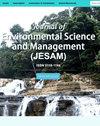Isolation, Identification and Heavy Metal Biosorption Assessment of Yeast Isolates Indigenous to Abandoned Mine Sites of Itogon Benguet, Philippines
IF 0.3
4区 环境科学与生态学
Q4 ENVIRONMENTAL SCIENCES
引用次数: 1
Abstract
Water samples collected from abandoned mining sites in Itogon, Benguet, Philippines were screened for metal resistant microorganisms, in particular yeasts that will be used to remove toxic metals such as Zn, Cu, Pb, Cr and Ni from aqueous media. Among the five yeast strains selected and five heavy metals tested, Nodulisporium sp. exhibited the highest removal efficiency of 80% and biosorption capacity of 56.7 mg g-1 for Pb. This was based on the model equation for each metal that was generated to derive optimum response for removal efficiency. The metal accumulation potential for all selected yeast isolates was generally higher at the lower initial metal concentration of 25 mg L-1, indicating rapid metal absorbing ability of the isolate and that adsorption sites in the biomass are taking up available metal ions more quickly. An increased removal capability was observed when the best isolate was applied in a semi-continuous treatment system thru an Aerobic Cascading Filter Bed Baffled Reactor (ACFBBR). The reactor design including the packing material remarkably enhanced the contact between the yeast biomass and Pb contaminated wastewater resulting in a much greater biosorption capacity of 170.14 mg g-1 as compared to the biosorption of 56.7 mg g-1 achieved during the batch adsorption experiment.菲律宾Itogon Benguet废弃矿区原生酵母菌的分离、鉴定及重金属吸附评价
从菲律宾Benguet的Itogon废弃矿场采集的水样中筛选了抗金属微生物,特别是用于从水介质中去除锌、铜、铅、铬和镍等有毒金属的酵母。在筛选的5个酵母菌株和测试的5种重金属中,结节孢菌对Pb的去除率最高,达80%,生物吸附能力为56.7mg-1。这是基于生成的每种金属的模型方程,以导出去除效率的最佳响应。在25mg L-1的较低初始金属浓度下,所有选定酵母分离物的金属积累潜力通常较高,这表明分离物具有快速的金属吸收能力,并且生物质中的吸附位点更快地吸收可用的金属离子。当通过好氧级联过滤床挡板反应器(ACFBBR)在半连续处理系统中应用最佳分离物时,观察到去除能力增加。包括填料的反应器设计显著增强了酵母生物质与Pb污染废水之间的接触,导致170.14 mg g-1的生物吸附能力比在分批吸附实验中实现的56.7 mg g-1大得多。
本文章由计算机程序翻译,如有差异,请以英文原文为准。
求助全文
约1分钟内获得全文
求助全文
来源期刊

Journal of Environmental Science and Management
ENVIRONMENTAL SCIENCES-
CiteScore
0.90
自引率
0.00%
发文量
10
审稿时长
2 months
期刊介绍:
The Journal of Environmental Science and Management (JESAM) is an international scientific journal produced semi-annually by the University of the Philippines Los Baños (UPLB).
JESAM gives particular premium to manuscript submissions that employ integrated methods resulting to analyses that provide new insights in environmental science, particularly in the areas of:
environmental planning and management;
protected areas development, planning, and management;
community-based resources management;
environmental chemistry and toxicology;
environmental restoration;
social theory and environment; and
environmental security and management.
 求助内容:
求助内容: 应助结果提醒方式:
应助结果提醒方式:


